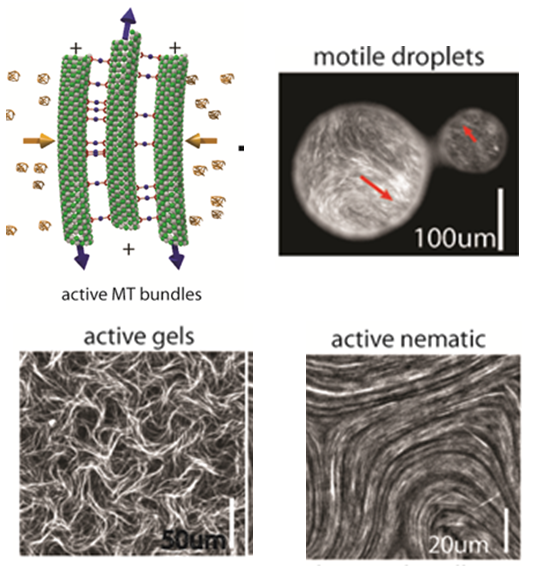Most conventional materials are assembled from inanimate building blocks. We have explored the behavior of soft materials in which constituent energy consuming units that are assembled from animate energy consuming components. Thousands of these components spontaneously coordinate their microscopic activity to yield novel gels, liquid crystals and emulsions that crawl, flow, stream, spontaneously fracture and self-heal, thus mimicking some of the characteristics of living biological organisms.
Behavior
of materials assembled from inanimate molecules is constrained by the laws of
equilibrium of statistical mechanics. We have assembled animate materials
assembled from filamentous microtubules and molecular motors. Being actively
driven, these materials are not constrained by the laws of equilibrium
statistical mechanics and can they exhibit sought-after properties such as
autonomous motility, internally generated flows and self-organized beating.
Starting from extensile microtubule bundles, we hierarchically assemble
far-from-equilibrium analogues of conventional polymer gels, liquid crystals
and emulsions. At high enough concentration the microtubules form a percolating
active network characterized by internally driven chaotic flows, hydrodynamic
instabilities, enhanced transport and fluid mixing. When confined to emulsion
droplets, three-dimensional networks spontaneously adsorb onto the droplet
surfaces to produce highly active two-dimensional nematic
liquid crystals whose streaming flows are controlled by internally generated
fractures and self-healing, as well as unbinding and annihilation of oppositely
charged disclination
defects. The resulting active emulsions exhibit unexpected properties, such as
autonomous motility, which are not observed in their passive analogues. Taken
together, these observations exemplify how assemblages of animate microscopic
objects exhibit collective biomimetic properties that are very different from
those found in materials assembled from inanimate building blocks, challenging
us to develop a theoretical framework that would allow for a systematic
engineering of their far-from-equilibrium material properties.
